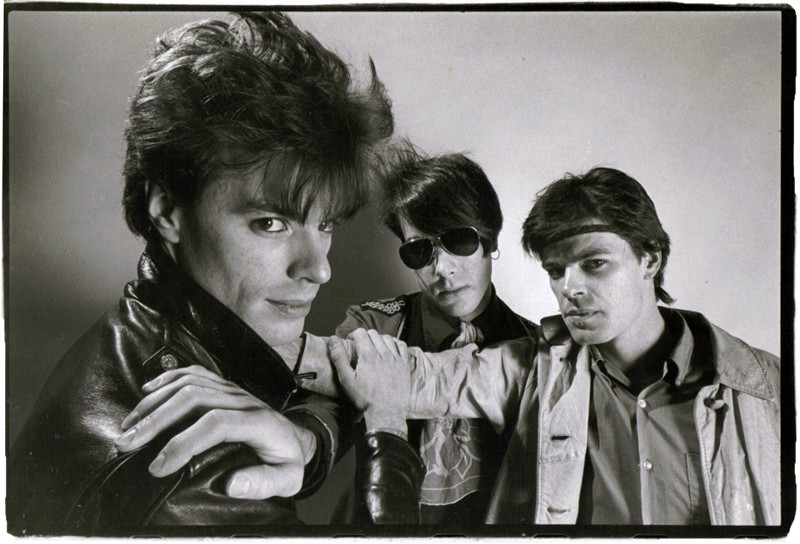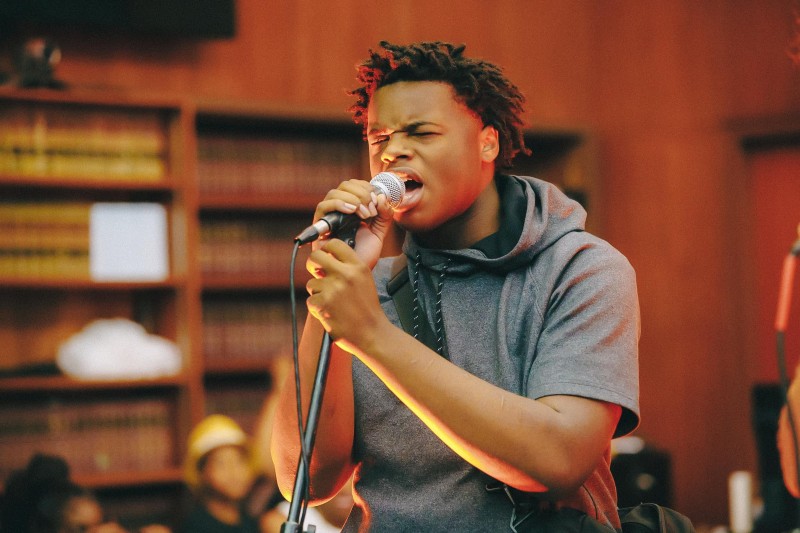(Re)Introducing Djangophonique: Andrew Brown and Co. are putting a modern spin on a jazz tradition

“When I say ‘modern music,’” says Andrew Brown, “what I mean is, like, anything after 1956.”
Brown is the band leader and lead guitarist for Djangophonique, the crisp Ann Arbor-based quartet that’s made a name for itself reveling in—and updating—the 1930s and 1940s music known as “gypsy jazz,” or jazz manouche. It's a sound primarily associated with the French-Romani guitarist Django Reinhardt, but Djangophonique applies the style to a range of genres, from country music to swing.
In 2020, Djangophonique released a live EP, Jazz Du Jour, some of which was recorded at the Blue Llama Jazz Club, but it came out just before the pandemic began. “That kind of put things on pause for a while,” Brown says.
But the band regrouped and last summer issued its first full-length album, Introducing Djangophonique, which garnered the quartet more and more attention. The group snagged some high-profile gigs, too, including the bluegrass-based Wheatland Music Festival, the Detroit Jazz Festival, and Ann Arbor's Top of the Park. While Djangophonique performs all over the area, its current home base is Ann Arbor's new North Star Lounge, where Brown is the creative director and the group has a residency most Wednesdays.
How Human: Lily Talmers returns to Ann Arbor with two new excellent albums that explore deeply personal and universal experiences

On "My Mortal Wound," the opening song on Lily Talmer's It's Unkind to Call You My Killer album, states in the chorus:
I’m alright; I am
Just the tide’s gone still and I’m left waiting for something to happen
For anything to happen; For good things to happen
Well, good things are happening for the Birmingham native and University of Michigan graduate.
In the past few months, she's released two terrific albums: the aforementioned Killer, an 11-track, stripped-down collection of songs performed live, and Hope Is The Whore I Go To, which features 10 strings-and-brass-colored tunes recorded in studios from Ypsilanti, Michigan to Brooklyn, New York.
Both albums highlight Talmer's exquisite amalgamation of 1960s folk-pop, Eastern European brass bands, and the melancholy melodies of Brazilian and Mediterranean music. Her twang-tinged voice is a slightly untamed powerhouse that's more than capable of delivering her heartfelt, poetic lyrics exploring personal and spiritual relationships with the drama and delicacy they deserve. Think of a jazz singer who hasn't sanded the edges off her voice but can still duck and weave in and out of the music like an instrumental virtuoso. (Canadian cult singer-songwriter Mary Margaret O'Hara is the closest analog to my ears.)
"If Hope Is The Whore I Go To is the primordial scream version of the message I’m trying toward," Talmers says in the interview below, "It's Unkind to Call You My Killer is the inward recoil. I’m telling you something in the first record, and in the second I’m kind of just admitting things to myself."
Since graduating from U-M, Talmers has moved to Brooklyn but makes frequent trips back home, including a stop on Sunday, January 8 at The Ark for her first headline show at the venue.
In 2021 Pulp did an extensive piece on Talmers for her debut full-length release, Remember Me As Holy, and in late summer of this year, former AADL public library associate Katy Trame talked to Talmers about her life and brilliant new records.
—Christopher Porter, Pulp
In Conversation: New AADL Video Revisits Dur e Aziz Amna's "American Fever" Debut Novel and Summer Event

A new Ann Arbor District Library video featuring a conversation with authors Dur e Aziz Amna and Julie Buntin is now available.
Recorded on August 26, 2022, it spotlights Amna discussing her debut novel American Fever.
In American Fever, Amna tells the story of 16-year-old Hira, who's on a yearlong exchange program in rural Oregon. Hira must swap Kashmiri chai for volleyball practice and understand why everyone around her seems to dislike Obama. A skeptically witty narrator, Hira finds herself stuck between worlds.
Kirkus calls American Fever "a funny and affecting novel ... a wonderful new spin on the coming-of-age story. A smart, charming debut."
Hailing from Rawalpindi Pakistan, Amna now lives in Newark, New Jersey. She graduated from Yale College and the Helen Zell Writers' Program at the University of Michigan. Amna also has been published in the New York Times, Financial Times, and Al Jazeera.
Everybody's Kranky: In a recorded talk, Bruce Adams discussed his recent book on the rise of Chicago's thriving 1990s independent music scene and the influential record label he cofounded

For a guy who cofounded a record label named kranky—small k, thanks—that used marketing slogans such as "Honk if you hate people, too," Bruce Adams is one of the nicest people in the music industry.
Adams' new book, You're With Stupid: kranky, Chicago, and the Reinvention of Indie Music, recalls not only the rise of his experimental label but also the inventive, genre-hopping sounds that were coming out of the city in the 1990s. It was also a time when major labels swooped into town to sign the likes of The Smashing Pumpkins, Urge Overkill, and Liz Phair after Nirvana showed corporations that the independent music scene could sometimes provide commercial hits.
A former Ann Arbor resident, Schoolkids Records employee, and WCBN-FM DJ, Adams moved to Chicago in 1987 to work for various music-distribution companies. He also worked at the influential Touch & Go Records as a publicist, handling bands such as Ann Arbor's Laughing Hyenas as well as Slint, Die Kreuzen, The Jesus Lizard, and many other bands that took the energy of punk rock and twisted it into new forms of dynamic and frequently very heavy music.
But in 1993, Adams and his colleague Joel Leoschke looked at the stacks of indie-rock CDs and 7-inches flooding into the Cargo Distribution warehouse where they worked and decided they wanted to do something completely different with their record label. The duo took their inspiration from 1970s progressive-music labels such as Editions EG, which counted Brian Eno's transformational ambient albums in its catalog, and ECM Records, which focused on jazz (and classical) that came from a more European approach to improvisation; more open to exploring space and unique timbres rather than blues-informed swing. They also looked toward German kosmische musik of 1970s groups such as Neu! and Cluster as well as then-contemporary psychedelic bands such as Spacemen 3, which played drone-based rock 'n' roll.
Adams and Leoschke wanted kranky to represent music that was artful, hazy, and deep—and they found the perfect first band for their new label: Labradford.
Prazision was the debut album by the Richmond-based duo (later trio) Labradford, which used guitars drenched in reverb, 1970s analog keyboards that weren't popular then, and sung-spoken vocals that blended into the vast smudge of ambient sounds.
The label went on to release albums by godspeed you! black emperor, Stars of the Lid, and kranky's most popular act, Low, the slowcore band fronted by the husband and wife duo of Alan Sparhawk and the recently deceased Mimi Parker. The label still continues to this day, releasing forward-looking music by Grouper and Jessica Bailiff as well as albums by Dearborn's Windy & Carl and Ann Arbor's Justin Walter.
Adams and Leoschke used what they learned from working for indie labels and distribution centers in order to not make the same mistakes they saw happening over and over: treat the bands with respect, pay them, and only release music you love. In the words of American poet Joe Perry, kranky "let the music do the talking."
A lot of music memoirs are filled with gossipy details, but since Adams really and truly is a nice guy, You're With Stupid avoids any deep, dark revelations or pointed barbs. It's more a survey of the vast amount of creative musical endeavors that defined Chicago in the 1990s rather than salacious tales of excess.
Adams discussed You're With Stupid at the Ann Arbor District Library's Downtown branch at 6:30 pm on Thursday, November 17. I was the guy interviewing him, and we talked about the kranky's groundbreaking music and the 1990s Chicago independent music scene.
A video of our chat is below, and for those unfamiliar with the label, Adams picked five tracks and added commentary to introduce new listeners to the kranky sound:
Ann Arbor Civic Theatre's take on "The Curious Incident of the Dog in the Night-Time" is a mystery that explores a spectrum of emotions and relationships

Cassie Mann was a fan of Mark Haddon’s best-selling novel The Curious Incident of the Dog in the Night-Time and was excited when Simon Stephens' stage version became a hit in London and New York.
“I went to New York and saw the Broadway version and just loved it,” she said. “It’s got so many elements to it. It’s a family drama, it’s got humor, it’s a mystery, it’s got themes of perseverance and it’s a good character-driven play and yet it’s got a love of fun stuff that goes along with it.”
Mann wanted to direct a production for the Ann Arbor Civic Theatre and was all set to stage it in 2021, when the show was canceled because of the pandemic. This pause gave Mann a chance to delve a little deeper into the play and its unusual perspective.
The Curious Incident of the Dog in the Night-Time begins as a mystery. Fifteen-year-old Christopher Boone discovers the corpse of a neighbor’s dog and sets out to discover who murdered the dog. Though never explicitly remarked on in Haddon’s novel or Stephens’ play, Christopher is on the autistic spectrum. The story of this mystery and what comes after is told from Christopher’s perspective as a sort of therapy suggested by his teacher, Siobhan.
The play is a family drama revolving around Christopher’s troubled relations with his parents. But it’s also a celebration of his determination, his wit, and his mathematical genius.
Mann read some books on autism and one book in particular influenced her approach to the play.
Who's Running the World? The Miller brothers' prolific musical output spans genres, decades, and all of 2022

When running down the famous musician alumni of what is now known as Ann Arbor's Pioneer High School, the list is pretty much always the same: Bob Seger, three members of The Stooges (Iggy Pop plus Ron and Scott Asheton), and Bill Kirchen of solo and Commander Cody fame.
But the most prolific musical grads with the most varied and creative musical styles who matriculated at the place formerly known as Ann Arbor High School are undoubtedly the Miller brothers, Roger and twins Laurence and Benjamin. The three of them formed the psychedelic rock band Sproton Layer while in high school, making an album in 1970 that went unreleased until 1992: the well-praised With Magnetic Fields Disrupted.
The brothers are the sons of Robert Miller, a University of Michigan ichthyologist, and Frances Hubbs, who together studied fish in desert springs as well as their fossil ancestors.
Roger left Ann Arbor to pursue composition studies at CalArts and then moved back across the country to Boston where he cofounded the influential art-punk band Mission of Burma in 1979. He also continued his experimental work exploring improv and prepared instruments and performed soundtracks to silent films in the Alloy Orchestra. He lives in Vermont now and continues to pursue creative endeavors, from art to music.
Laurence and Benjamin have moved around, too, with the latter living in Chicago and then New York City between 1993-2014. But they have since circled back to the region where they grew up and continue to conjure an endless series of creative projects tackling every genre, from serial compositions to children's songs.
As with Roger, the twins' musical output continues to this day, with Benjamin usually exploring the further edges of sound on new recordings and Laurence digging through his endless supply of tapes from throughout his career, cleaning them up, and releasing them on Bandcamp. The twins (and sometimes Roger) also still perform together in various new or revived projects.
In the summer of 2022, I realized all three Miller brothers had albums coming out—some new, some reissues, some unheard—and also discovered a few recordings by them from earlier in the year that I missed.
One of those releases is by a nervy, new wave-era trio called Nønfiction that Laurence and Benjamin helmed from late 1981 to spring 1985—and the group was reforming for a one-off show at the 2022 FuzzFest in August at The Blind Pig, though it would feature Ben's son on drums rather than original member Bill Frank.
I emailed the twins to find out more about that band (and some of their other recent releases) with the intention to do a Nønfiction profile before the concert, but Laurence was diagnosed with COVID a week before the gig, and the trio had to cancel its FuzzFest appearance. (Benjamin has since gotten COVID, too, and is still feeling the effects.)
Rather than abandon the quotes Laurence and Benjamin sent me for the now-stalled feature, I decided to incorporate them into a post that highlights the Miller brothers' numerous 2022 releases—including a new album from Roger—that Pulp had yet to cover this year. (Links to the articles featuring all of the Miller music we've already covered are at the bottom of this piece.)
The Miller brothers' circuitous musical journey deserves an in-depth interview and probably requires a map to follow accurately—perhaps a future Pulp project?—so consider this article a brief introduction to their long creative histories by way of the new and old music they released in 2022.
Out of the Cave: Rapper Killa Kam stepped into the spotlight in 2022 with an outstanding debut album

Killa Kam has the kind of speedy and confident flow that pairs well with an atypical hip-hop producer like Scary Steve Klingbiel, who mixes in off-kilter sounds with his beats that might trip up a less talented rapper.
Together, the duo produced the excellent Cave That I Left album, which showcases a dynamic new voice on the Washtenaw County music scene.
Formula 734’s “Volume II” Album Documents Post-Pandemic Perseverance for Washtenaw County Men of Color

Formula 734’s Volume II chronicles the ongoing perseverance of Washtenaw County men of color in a post-pandemic world.
The hip-hop collective’s second community-based album features insightful tales of self-determination by lyricists confronting daily struggles and aspiring for future change.
“Coming out of COVID, we’ve had to appraise our value of everything. In listening to the young guys, they’re using music to appraise their thoughts about relationships, school, and mortality,” said Rod Wallace, who co-executive produced the album with Jamall “Buff1” Bufford.
“We always say that kids are a lot more resilient than adults are … but in the same token, when they look back and when we look back at this time, it was a time the entire world transitioned in a way. This music is them making sense of that transition.”
To ease that transition, Wallace and Bufford reassembled an intergenerational team of men to write and record 10 cathartic tracks for Formula 734’s Volume II.
They created the album in partnership with Washtenaw My Brother’s Keeper, the Ann Arbor Community Foundation, the Washtenaw County Prosecutor’s Office, Project Plugin, and Creativity Fluidity Productions.
Fine Tuning: Martin Bandyke says goodbye to his morning radio show and hello to having even more time for music

It always seems like Martin Bandyke is smiling on the radio.
A grin doesn't make a sound, but the way Bandyke enunciates his words and presents them to his audience every morning on 107.1-FM gives listeners the impression he's speaking through a smile.
A recent visit to the WQKL studios near Briarwood Mall in Ann Arbor confirmed as much:
He actually is smiling as he speaks.
Whether reading traffic updates or music news, Bandyke projects the sort of positivity people appreciate when they're trapped in their cars during a morning commute or settling in for another day of the 9 to 5.
The DJ's convivial charms have radiated through the radio for 40 years—starting in 1983 on WDET 101.9-FM in Detroit—but on December 22, Bandyke is stepping away from his morning-drive show and entering semi-retirement at age 68. He'll still host his long-running Fine Tuning program every Sunday afternoon on the station, still choosing every song that's played on the show, just as he did during his public radio days.
Bandyke's first stint on the air was in 1983 co-hosting WDET's Monday night show Dimension. He had been trying to get his foot in the door of Detroit radio ever since graduating from the University of Michigan in 1976 with a bachelor of arts degree in radio, television, and film. His on-air opportunity came when he was a music buyer for his hometown Dearborn Music record store. Bandyke, a drummer, and Ralph Valdez, his longtime friend and frequent bandmate, were invited to co-host Dimension, which they did together through 1990. While Valdez continued to host Dimension, which moved to Sunday nights, that year Bandyke was hired full-time as the assistant music director, and in 1991 he took over Judy Adams' on-air shift from 10 am to 1 pm. He later moved to afternoons and in 1995 added music director to his duties at the station.
This is the part of the tale where Bandyke's voice and expansive music tastes entered my life.
Pull up a chair and let grandpa tell you a story.
Sparks and Sawdust: Erin Hahn's romance novel "Built to Last" reunites childhood sweethearts on a home renovation TV show

A house is not the only thing being fixed up in Erin Hahn’s new novel, Built to Last.
Two childhood stars, Shelby Springfield and Cameron Riggs, try to rekindle their love when they are brought back together for a home renovation TV program set in Michigan—though things get off to a rocky start, not unlike how things ended. Lyle Jessup, their other costar and the person who caused conflict when Shelby dated him after Cameron, turns out to be the one who brings them together with his TV pilot proposal. While Lyle never left Hollywood and its gossip, Shelby and Cameron have diverged on their paths and must find out if they can work together again—and even have another try at a relationship.
During a visit from Lyle, who becomes the showrunner, the now sober Shelby watches Cameron’s longtime friends, Beth and Kevin, at their bar:
My cheeks hurt from smiling so hard and the fizzy ginger ale does a little swirl in my stomach. These two make it look so simple. You meet, you fall in love, you get married and have babies, and you spend the rest of your life with that one person who likes you best, who you like best.
Both Cameron and Shelby are wildly attracted to each other, but the question becomes whether they can push past the drama of filming and reconnect.
Cameron reflects, “Maybe I wasn’t looking for something to tie me down. Maybe I’ve been looking for someone, an anchor. And not just any someone. Not like the proverbial 'someone,' but her. As in, she is the only one.” He senses how important Shelby is, but their relationship could either be just a pivotal part of growing up or a long-lost—and now found—real deal.
Hahn lives in Ann Arbor with her husband and two kids. Previously, I interviewed her about her last book, 2021's Never Saw You Coming. We connected again to discuss Built to Last, Hahn’s fourth book.


































